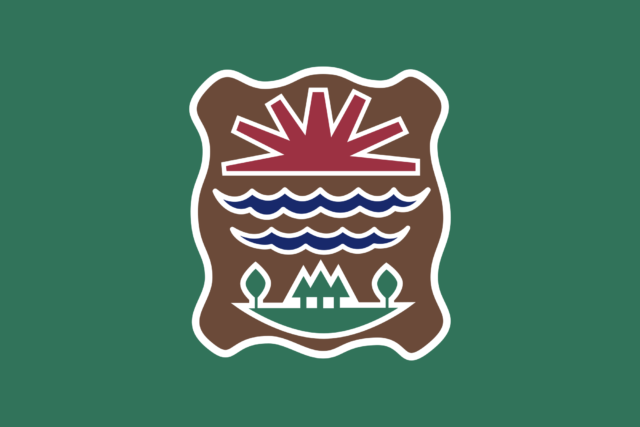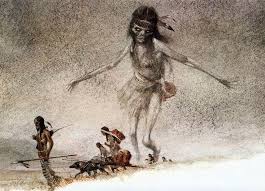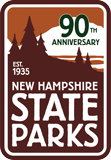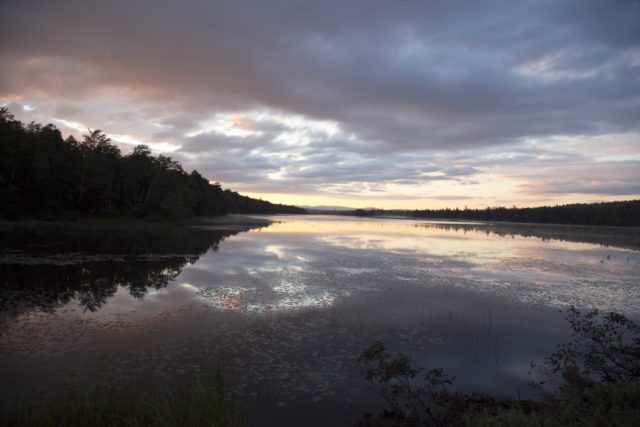By Donny Palumbo, Interpretive Ranger at Umbagog Lake
The winds up here in the North Country have begun to pick up. As I write, I notice some of the leaves have just barely started to turn. It may still be warm, but the smell of fall is not altogether indistinct blowing on the cool air. Autumn will return soon like an old friend, bringing with it that old chill, a delightful harbinger of changing seasons, saving us from the August humidity. With that familiar coldness in the air we can be sure that campfires will burn late into the night, and with them primal vibrations driving us to huddle together and share stories over the happy crackle of the flame. Umbagog – my home for the last two months – has no shortage of stories. Today, reader, I want to take you on a journey through some of them.

People have inhabited the Umbagog area for 11,000 years, eventually being occupied by the Algonquian Natives. These were one of the most populous Native groups in the United States and occupied areas of New England. These peoples were no strangers to New Hamphire, specifically, the Umbagog area. In fact the name Umbagog is Abenaki for shallow water; the Abenaki being an Algonquian people, identified by linguistic and geographical similarities. Historically there was no strong central authority, but several semi-nomadic tribes with great similarities in cultural traits. For example, the tribes would construct Wigwams, small and easily transportable shelters made from a small frame utilizing large birch bark patches as cover.

Of the Abenaki peoples, one individual’s legacy endures associated with Umbagog: Chief Metallak, last of the Cowasucks (One of the numerous bands of Abenaki). Known as the “Lone Indian of the Magalloway”, Metallak was revered as a master hunter, trapper, fisherman, and guide who was friend to the white settlers of the area. He remained in the Errol/Cambridge area until he was blinded by two separate incidents, each robbing him of sight in one eye respectively. His presence is still felt today in that Metallak Island is one of the islands on Umbagog Lake. There are stories of Metallak that are still recounted, such as riding moose or swearing life-long vengeance on wolves for the killing of his wife. He was also a skilled leader who received widespread recognition for his skills and personality, as evidenced by the many landmarks (ponds, mountains, etc.) named after Metallak in the area. He died reportedly at the age of 114 in Stewardstown New Hampshire, where his grave resides.

These decidedly historical accounts however are not the only interesting bits of culture to remain in the Great Woods. In fact, there are plenty of Algonquian and Abenaki stories bubbling up from the cauldron of the folklore and legend dealing in darkness and mystery. These creatures and cautionary tales resulted from a time when the only way to transfer value was by word of mouth, perhaps around a campfire. In this way, the Native peoples of the land created parables and folklore – in many instances to ward young ones from dangerous places or explain the wonders of their world unlit by modern technology. And besides, who doesn’t love a good spooky story?
Giwakwa
The first of the creatures to crawl – or rather stomp out of Abenaki mythology is the Giwakwa (gee-wock-wah). This behemoth stood tall as the tallest white pine, and tore these huge trees from the ground to swat humans. There are several different accounts of what a Giwakwa looks like, probably a result of the story passing from storyteller to storyteller, like a great game of telephone. It was said they rolled in Balsam Fir sap, picking up the rest of the clutter on the forest floor – making them a hulking mass of forest. Up top, their glowing eyes were matched by the gleam of their sharp white teeth that they used to tear into humans wandering through the forest. Often they are depicted as having a heart of ice, or a human shaped ice block in their stomach. In fact, this ice can sometimes be thawed by clever folk heroes, returning the monster to human form, as many of these giants were individuals who are cursed, either through malevolence or by committing a heinous crime like cannibalism.

Mskagwdemos
The second of the creatures we’ll discuss that inhabited the Great North Woods is the Mskagwdemos (muh-skog-day-moose) or Swamp Woman. The Swamp Woman is never seen; those who have seen it, did not live to tell the tale. She inhabits the swamp and howls mournful cries trying to attract hapless travelers or wanderers out after dark. Anyone who follows the cry will inevitably become lost and killed in the swamp. Her character has been variously portrayed as a tragic figure, calling out in sincere loneliness after being trapped in the swamp forever. The alternate, sinister telling, is that her cries are in fact a lure – because you are going to be her dinner. Her story acted primarily as a bogeyman figure to keep children and others from wandering out after dark, especially into a swamp where a wanderer absolutely could find themselves in real material danger.
Skadegamutc
Next, I would like to introduce you to the Skadegamutc, also known as the Ghost-Witch. Pronounced scah-day-gah-mooch, these are malignant sorcerers of black magic who after death remain as spirits to exert otherworldly torment on the living. It is said they are the result of the magician’s will to stay alive, and so they transcend death. These are shape-shifters, prowlers of the nocturnal hunting ground, and will scour the forest looking for people to curse or consume. Their only weakness is fire, and of course, the brilliant light of day.

Keep in mind that these stories were told in these woods that currently surround me on every side. Perhaps there’s a Giwakwa hammering around between the pines out across the shore right now. While some of these strings of narrative are incredibly interesting, and great for chilling some spines around a campfire, it is important to remember that the history of a space is integral to its existence as it is today. As for Umbagog Lake, we have barely scratched the surface of all it is connected too, both culturally and historically. For those interested in learn more, every Saturday at 2:00 we host the Experience Umbagog Boat Tour where guests ride out onto the entirety of the lake and learn about its ecological and historical significance. It is $15.00 per adult, and $10.00 a child. In the meantime, enjoy the remainder of the summer night campfires. Make sure they stay lit. Lest the ghost-witch pay you a visit.
I’ll be offering Nature Programs here at Umbagog Lake State Park all summer so check out my program schedule and come Discover the Power of Parks! Friday nights at 8:00 we huddle around the campfire fire, learn to make banana boats, and share spooky stories!


“Chief Metallak, last of the Cowasucks (One of the numerous bands of Abenaki)”
Last of who? Apparently the author of this article is believe what other colonizer descendant authors have written as per their perceptions about Louie Metallic and his people!
Because I will tell you right here, right now, that there is in fact, a descendant of Louie Metallic living in Colebrook, Coos County, New Hampshire this very month of October, in the year of our Lord, two thousand and sixteen! And there are THOUSANDS of his descendants all up and down the Eastern Coastline of North American, and some are Chiefs of legitimate Indian Communities up on the Gaspe. Apparently this author, along with other authors, are either naive or blind genealogically-speaking. Louie Metallic’s descendants are alive and well, THOUSANDS of them !!
“Last of the Cowasucks” ? Really ? Because Louie Metallic of ca. 1796 Y-DNA is C-P39 and how do I know this without digging up Louie Metallic? Because I called up his direct male descendant and asked for a DNA sample! Louie Metallic wasn’t the last of his people at all. As for Chief Philipp of the Upper Coos here in New Hampshire ca. 1796, well he’s also got THoUSANDS of descendants as well.